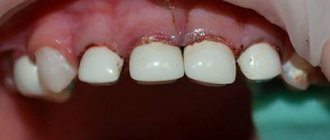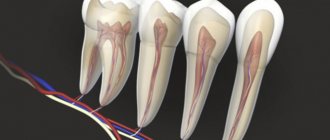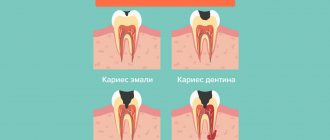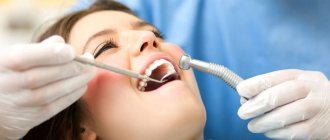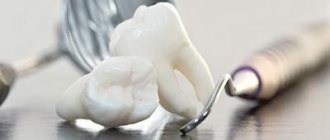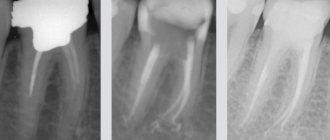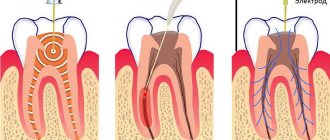“Pulpitis” is a professional dental term that is used in the case of active development of the inflammatory process in the dental nerve or, in other words, the pulp, which is a bundle of nervous tissue and capillaries and is located inside the tooth. Pulpitis is accompanied by sharp and excruciating pain, which is almost not relieved by painkillers, and if you do not rush to see a doctor, the development of inflammation in the pulp can lead to the need to remove a tooth in a row.
In the review material, we will examine in detail the factors that provoke the occurrence of pulpitis, find out its main symptoms, and also talk about how pulpitis is treated and whether it will be painful for the patient.
Calculate the cost of treatment by taking a short test in 20 seconds!
Do not delay your treatment, because in this matter time plays against us.
Causes of pulpitis and its symptoms
There are several reasons why an inflammatory process can be initiated in the dental pulp:
1. Advanced caries has reached a deep stage of development, in which destruction has reached the pulp, and pathogenic microflora has penetrated into it.
2. Low-quality caries therapy, in which the specialist did not completely eliminate carious dentin. If you fill a poorly treated tooth, then caries in it begins to develop at an active pace and the pathogenic microflora will penetrate into the pulp tissue after some time.
Less common is pulpitis of hematogenous etiology, which occurs when infection penetrates through the blood, when some general viral disease affects the areas of the face and jaw.
Dental pulpitis has its own characteristic symptoms, the most striking of which is pain. The nature of pain manifestations during inflammation of the pulp chamber can vary from mild pain, which appears mainly when eating too cold or too hot food, to acute pain that cannot be relieved even by taking strong anesthetics.
In general, the symptoms of pulpitis will depend on its form, which can be acute or chronic. Let us consider in detail the symptoms of each form of pulp inflammation.
Prerequisites
The most common cause of inflammation of the dental nerve (pulp) is the presence of caries. And in a deep stage. The infection reaches the soft tissues through the destroyed tooth tissue, provoking an inflammatory process. A similar situation occurs when a filling falls out or is damaged, when the pulp is “exposed.”
Bacteria can enter the tooth cavity from another source of infection in the body. Inflammation also occurs when a tooth is injured, minerals accumulate in the pulp, or low-quality components are used when filling canals.
Also, treatment of pulpitis may be required if the nerve overheats during preparatory procedures for prosthetics. If there is increased sensitivity, swelling of the pulp can be caused by the use of chemicals during therapy. It is also possible that an infection may accidentally enter the pulp chamber when eliminating a carious cavity.
Acute pulpitis
This phase of the development of the disease will be characterized by sharp and unbearable pain, which manifests itself in attacks. Most often, pain in acute pulpitis bothers patients at night, starting with minor pain and gradually turning into painful sensations. If treatment for pulpitis is not started, attacks will gradually become more frequent, and the pain will become more severe.
In acute pulpitis, pain in the tooth usually manifests itself without exposure to external irritants, but sometimes painful manifestations can occur after eating something cold or hot.
Pain provoked by an external irritant may subside after it is eliminated, but it will take a long time to subside for about 20-30 minutes. This characteristic feature makes it possible to distinguish tooth pulpitis from other dental diseases. In case of carious lesions of tooth tissue, pain symptoms disappear immediately after the external factor that provoked discomfort in the area of the diseased unit is eliminated.
Sometimes, with acute pulpitis, even the patient himself cannot accurately determine which specific dental unit is hurting, since painful manifestations from the pulp can be transmitted along the nervous tissue to healthy “neighbors”. At the slightest suspicion of acute pulpitis, treatment should begin in the dentist’s office, since the process can become purulent.
Prevention
The main way to prevent pulpitis is timely and correct treatment of caries in children. To prevent tooth infection, it is important to pay attention to hygiene by teaching your child how to brush their teeth correctly from an early age. It is also important to monitor the baby’s nutrition, providing his body with the necessary nutrients, in particular, minerals important for teeth. Sugary foods should be limited, and only water should be given to drink at night.
Pulpitis in children is a more common situation than in adults. It causes children a lot of pain and discomfort. Most often, the lower teeth are affected by this disease. Treatment of pulpitis of a baby tooth cannot be put off for a long time, because this will lead to irreparable consequences. The worst results will be tissue suppuration, infection, and malocclusion.
Treatment of pulpitis of primary teeth in our clinic is carried out in one appointment. The child is under the influence of an anesthetic and does not feel pain. The price of such treatment is affordable for the city of Moscow. We use modern technologies and high professionalism of doctors. Our dentists will heal your children’s teeth quickly, without losing quality.
Methods used to treat pulpitis
Treatment of pulpitis most often involves a depulpation procedure, in which the doctor completely removes the dental nerve. Then the specialist must expand the root canals of the tooth with a special device and carry out antiseptic treatment with subsequent filling. This technology for the treatment of pulpitis is used in relation to adult patients: in children and adolescents, young people under 25 years of age, it is sometimes possible to treat the disease without the use of a pulp removal procedure.
Ideally, it is advisable to treat pulpitis without removing the nerve, since pulpless teeth become less durable and their enamel coating may turn gray. But in order to avoid tooth depulpation, you need to consult a dentist at the first suspicion of pulpitis, and not wait until the pain becomes unbearable and cannot be relieved with drugs from your home medicine cabinet. Next, we will consider in detail all the stages of traditional treatment of dental pulpitis.
Traditional
In most pediatric dentistry in public institutions, pulpitis is treated in a method called “devital amputation.” It involves several visits to the dentist:
- On the first visit, the nerve is opened and a paste with devitalizing properties is applied to it (it “kills” the pulp). If it contains arsenic, then keep the paste in the tooth for 24-48 hours. Arsenic-free paste is applied for a period of up to 7 days.
- In the next two visits, a special mixture is “pumped” into the tooth canals to mummify the infected pulp. Usually this is a resorcinol-formalin mixture.
- At the next visit, a permanent filling is installed.
Treatment of pulpitis with removal of the dental nerve
In almost 90% of cases, treatment of tooth pulpitis is carried out by the depulpation procedure, which includes the following main stages:
- Removal of the enamel layer and dentin on which carious lesions are present.
- Removal of the dental nerve, in which the doctor uses specialized instruments.
- The procedure for expanding dental canals and their subsequent filling.
- Restoration of a natural tooth crown
Each stage of the pulpitis treatment process must be carried out efficiently, otherwise various negative consequences for human health are possible. In our dentistry in Moscow - Vanstom you will find services of a European level of quality, and a guaranteed individual approach to each patient. The clinic has a convenient location - we are located in the center of Moscow, next to the Baumanskaya metro station. You can make an appointment with Vanstom doctors by phone or using the call back service on our website.
Treatment of pulpitis occurs in several visits to the doctor, the exact number of which will depend on the complexity of the case, as well as on which particular unit in the series is supposed to be depulped. If you need to cure pulpitis on a tooth with one root and a single canal, the course of therapy involves two visits to the dentist’s office; if there are more roots, you will have to visit the doctor 3-4 times.
A key point to know: when treating dental pulpitis, a permanent filling is never installed immediately after filling the dental canals. It takes time for the composite to harden in them and for excess moisture to evaporate from it. And only after these processes are completed, the dentist will be able to restore the natural crown of the tooth by installing a permanent filling.
Below we will study in detail all the stages of treatment of pulpitis of a multi-rooted tooth.
Modern methods of treatment
Anyone who has ever experienced acute toothache due to pulpitis is primarily interested in how to cure this disease as quickly, efficiently and as painlessly as possible. Treatment is aimed at eliminating the inflammatory process in the dental pulp. The main methods of treatment are biological and surgical. With the biological or conservative method, the pulp is preserved, but with the surgical method, it is completely removed, after which the canals are sealed. Let's take a closer look at both of these methods.
Biological method
Conservative treatment of pulpitis, or the so-called biological method, is possible only in the early stages of the disease, when the inflammatory process in the pulp is reversible. This treatment does not involve removing the dental nerve, so the tooth remains alive. Most often, conservative treatment is used in the following cases:
- with traumatic pulpitis;
- accidental opening of the pulp chamber;
- treatment of young patients without a history of chronic diseases.
Treatment without removing the nerve involves the following actions by the dentist:
- use of antibacterial and calcium-containing drugs;
- the use of physiotherapeutic procedures to sanitize the pulp and restore the alkaline reaction;
- systematic x-ray monitoring of the treated tooth to prevent the transition of the inflammatory process to the chronic stage.
In case of traumatic pulpitis, the doctor carefully treats the exposed pulp with antiseptic agents, then applies a pad with calcium hydroxide, and then seals the tooth with a temporary filling. And although the likelihood of recovery after such treatment is very high, the doctor should advise the patient to undergo systematic X-ray monitoring.
Surgical removal of the nerve
Surgical treatment by amputation involves opening the pulp and removing the dental nerve. It should be noted that both acute and chronic pulpitis are treated surgically.
The surgical method is divided into two types - vital and non-vital:
- With the devitalizing method, the nerve of the tooth is killed using so-called devitalizing agents, which include arsenic, as well as modern arsenic-free drugs. In this case, removal is carried out without anesthesia. It should be noted that treatment with arsenic requires high qualifications from the doctor, because the quality of its effect on the pulp depends on the correct installation of the medicine in the tooth cavity.
- With the vital method, the doctor does not use drugs that kill the dental nerve, and the treatment itself takes place under anesthesia, so the patient does not feel pain. The nerve is removed under local anesthesia, so pain-free treatment is not a fairy tale; it is quite possible with proper pain relief. The doctor injects an anesthetic into the patient’s gums, opens and removes the pulp, and thoroughly cleans the root canals, removing nerve endings. Next, you should thoroughly rinse the root canals with antiseptic solutions to prevent relapse of the inflammatory process.
The treatment algorithm for pulpitis depends on the condition of the tooth, the complexity and severity of the inflammatory process. Treatment in one visit to the dental clinic is quite possible. After analyzing the condition of the tooth, the doctor may decide to fill the root canals immediately after treating them with antiseptic drugs and thoroughly drying them. The canals must be sealed very tightly; you should definitely take a control photo to ensure that the canals are tightly sealed. Next, a filling is placed on the carious cavity, with the help of filling material the appearance of the tooth is restored, after which the treatment is considered complete.
In more complex and advanced cases, the doctor may offer the patient step-by-step treatment. In this case, the canals are first filled and a control x-ray is taken, after which the carious cavity is closed with a temporary filling for several days. After the filling material inside the canals has hardened, the doctor fills the tooth with a permanent filling made of composite materials and restores its shape.
Laser
Treatment of pulpitis without a drill is the dream of everyone who has experienced acute toothache. Thanks to modern methods of therapy in dentistry, this dream has become a reality. One such therapy is the use of a dental laser.
The laser allows you to painlessly and safely cure pulpitis, while keeping the pulp alive. Laser radiation activates metabolic processes in tooth tissues and helps stop the inflammatory process, while stimulating the process of regeneration of pulp cells. Within 24 hours after the procedure, pain is relieved and tooth function is restored. The most effective use of laser is in the treatment of focal pulpitis.
Depophoresis
Depophoresis is another modern method of treating pulpitis, which is successfully used in dental clinics. Thanks to depophoresis, it is possible to eliminate inflammatory processes in the root canals, which is extremely important when the canals are obstructed and it is impossible to clear them of pulp residues mechanically. Depophoresis is effective in treating advanced stages, when there is a tendency to form cysts and granulomas. Under the influence of an electric field and copper-calcium hydroxide, the remaining pulp in the root canals completely disintegrates, which ensures the impossibility of further development of the inflammatory process. With the help of depophoresis, retrograde pulpitis, acute partial and other forms of the disease, as well as canine pulpitis are effectively treated.
Physiotherapy
Physiotherapeutic therapy for pulpitis is supportive of other methods of treating the disease. A very effective anti-inflammatory method is pulpitis therapy with UHF, which helps to resolve the inflammation in the pulp and reduce pain. No less effective is infrared laser therapy, which has a positive effect on the regeneration of pulp tissue. The diatemocoagulation method prevents the penetration of infection into periodontal tissue. Transcanal iodine electrophoresis stimulates the regeneration of pulp and periodontal tissue, which helps to avoid complications such as apical periodontitis.
Stages of treatment of pulpitis of a multi-rooted tooth
Treatment of pulpitis begins with an initial visit to the dentist, during which the doctor conducts a thorough examination of the patient and makes a diagnosis (most often after an x-ray). Further therapy for pulp inflammation is divided into the following main stages:
How to deal with the disease
At the initial stage, it is not difficult to cope with pulpitis. The nerve in the tooth is preserved, and the doctor relieves the inflammation using therapeutic procedures.
The biological treatment method eliminates inflammation through antibacterial treatment of the damaged tooth, without removing the nerve. After removing carious tissue and disinfecting the pulp chamber, the dentist applies a compress with calcium hydroxide and fixes a temporary filling.
Then, after 3-7 days, during a follow-up visit, the doctor takes an x-ray. If there is no inflammatory process, then a permanent filling is installed. However, this technique requires a highly qualified doctor, so it is rarely used. For example, with traumatic inflammation of the dental nerve.
Preserving the pulp is important because... If it is present, the tooth is constantly strengthened due to the production of dentin. Conservative therapy has age restrictions - it is carried out up to 30 years.
Introduction of an anesthetic drug
It is impossible to do without anesthesia when treating pulpitis. When the pulp is damaged, the nervous tissue becomes inflamed and therefore any therapeutic manipulations will be unbearably painful for the patient. Therefore, before starting treatment of pulpitis, the doctor will administer an anesthetic, the action of which will remove the pain for the time necessary for carrying out therapeutic actions.
Sometimes, even after the administration of pain medication, the patient may feel pain. This suggests that either the amount of the drug was calculated incorrectly, or that the doctor made a mistake when giving the injection. Do you want to cure pulpitis painlessly and efficiently? Contact the specialists of the Vanstom dental clinic in Moscow! Our dentistry works for you at the address: Moscow, Baumanskaya metro station, st. Bakuninskaya, 17/28.
Clinical researches
Clinical studies have proven that regular use of professional toothpaste ASEPTA REMINERALIZATION improved the condition of the enamel by 64% and reduced tooth sensitivity by 66% after just 4 weeks.
Sources:
- Clinical and laboratory assessment of the influence of domestic therapeutic and prophylactic toothpaste based on plant extracts on the condition of the oral cavity in patients with simple marginal gingivitis. Doctor of Medical Sciences, Professor Elovikova T.M.1, Candidate of Chemical Sciences, Associate Professor Ermishina E.Yu. 2, Doctor of Technical Sciences Associate Professor Belokonova N.A. 2 Department of Therapeutic Dentistry USMU1, Department of General Chemistry USMU2
- Study of the clinical effectiveness of treatment and prophylactic agents of the Asepta line in the treatment of inflammatory periodontal diseases (A.I. Grudyanov, I.Yu. Aleksandrovskaya, V.Yu. Korzunina) A.I. GRUDYANOV, Doctor of Medical Sciences, Prof., Head of Department I.Yu. ALEXANDROVSKAYA, Ph.D. V.Yu. KORZUNINA, asp. Department of Periodontology, Central Research Institute of Dentistry and Maxillofacial Surgery, Rosmedtekhnologii, Moscow
- The role of anti-inflammatory rinse in the treatment of periodontal diseases (L.Yu. Orekhova, A.A. Leontyev, S.B. Ulitovsky) L.Yu. OREKHOVA, Doctor of Medical Sciences, Prof., Head of Department; A.A. LEONTIEV, dentist; S.B. ULITOVSKY, Doctor of Medical Sciences, Prof. Department of Therapeutic Dentistry of St. Petersburg State Medical University named after. acad. I. P. Pavlova
- Report on the determination/confirmation of the preventive properties of personal oral hygiene products “ASEPTA PLUS” Remineralization doctor-researcher A.A. Leontyev, head Department of Preventive Dentistry, Doctor of Medical Sciences, Professor S.B. Ulitovsky First St. Petersburg State Medical University named after. acad. I.P. Pavlova, Department of Preventive Dentistry
- Clinical studies of antisensitive toothpaste “Asepta Sensitive” (A.A. Leontyev, O.V. Kalinina, S.B. Ulitovsky) A.A. LEONTIEV, dentist O.V. KALININA, dentist S.B. ULITOVSKY, Doctor of Medical Sciences, Prof. Department of Therapeutic Dentistry, St. Petersburg State Medical University named after. acad. I.P. Pavlova
Elimination of tissue damaged by caries
Most often, tooth pulpitis is a consequence of advanced deep caries, and therefore, when treating inflammation in the pulp, a mandatory procedure is the elimination of the enamel layer and dentin with carious lesions. Damaged tissue is removed with a special tool using a drill.
However, when treating pulpitis, intact tissue will be partially removed; this is necessary to gain access to the pulp chamber and canal stomata that need to be treated.
Eliminate cannot be deleted
A term that patients in all fields of medicine fear is chronic disease. Let's see what the consequences are in our case. Inflammation of the dental nerve with chronic pulpitis lasts from a month to several years. The pain syndrome remains, but becomes less pronounced. Seizures occur periodically. The patient can no longer chew on the side of the diseased tooth. The affected nerve begins to bleed and dentin continues to deteriorate. Chronic pulpitis is also characterized by several phases:
- Fibrous. Relatively “easy” stage. It occurs when carious tissues are not located close to the dental nerve. Unpleasant sensations occur only when you press on the tooth.
- Gangrenous. The pulp tissue is completely infected. The nerve changes color. The pain becomes more noticeable. The tooth is deeply affected by caries.
- Hypertrophic. Bacteria destroy the tooth down to the pulp chamber, connecting both cavities. A polyp grows in the vacated space, causing the nerve to bleed. The pain syndrome persists.
- Exacerbation. The final stage of the disease, when the patient is attacked by periodic attacks of pain, combined with constant aching unpleasant sensations. Pus appears in the tooth cavity, inflammation spreads to the tooth root, and periodontitis develops.
In 90% of cases, doctors treat fibrous pulpitis, less often - the second stage. In general, chronic inflammation is an irreversible process. The only solution is to remove the damaged dental nerve.
Pulp extraction
Before removing pulp from the coronal area of the tooth, as well as from the dental canals, the manipulation area must be carefully isolated from moisture. This is done so that pathogenic microflora does not enter the canals along with saliva. For high-quality tooth isolation, a specialized latex rubber dam is used.
The process of pulp extraction itself is carried out with a special tool, on which the pulp is wound and then pulled out. Next, the doctor proceeds to a particularly important point in the treatment of pulpitis - measuring the length of the tooth canals. Measurements must be carried out with maximum accuracy, since errors in them are fraught with the following negative consequences:
• The canals will be unfilled, which can provoke various complications after treatment of pulpitis; • The canals will be refilled and excess material in them will cause pain and can even lead to trauma to the nervous tissue of the lower jaw.
To obtain accurate data on the length of the root canals, the patient is prescribed an X-ray examination, and the specialist also uses a special type of device, an apex locator. This device is equipped with K-files that are inserted into the canal stoma, and the specialist will advance them in depth until the apex locator monitor receives an alert that the instrument has reached the top of the tooth root.
An apex locator measures the length of each root, since they are unique both in this indicator and in structure. The data obtained during the measurements are recorded, but the procedure does not end there: at the next stage, the doctor enters K-files into all canals at once and takes a control image necessary to obtain the most accurate picture of the depth of the roots.
Inflammation of the nerve in the wisdom tooth
Eights have their own specifics, and the doctor often chooses to remove the tooth. The complexity of therapy is due to the anatomical features of the third molars. Curved roots, lack of access to the tooth, partial overlap of the gums equates the treatment of pulpitis in figure eights to jewelry work. And it requires experience and high qualifications of a doctor.
An inflamed nerve in a wisdom tooth can be treated by filling the canals. Provided that there is access to the root and the dental canals have good patency. It makes sense to preserve a tooth in the presence of an antagonist tooth, if the tooth is involved in the chewing process and is used when installing a prosthesis.
Primary canal treatment and installation of a temporary filling
High-quality treatment of tooth pulpitis involves preliminary mechanical expansion of the root canals and their subsequent filling, first temporary and then permanent. The channels are also expanded with a special tool using K-files or reamers. In order to make the necessary expansion, the doctor carefully rotates the K-file and its cutting edges remove chips from the canal walls. It is necessary to increase the size of the canal manually in order to subsequently perform a high-quality filling.
All canals are processed in a similar way to the depth determined by the apex locator and control radiography. During the mechanical treatment, the canals are also constantly washed with antiseptic agents to eliminate the risk of infection entering the root part of the tooth, as well as to eliminate chips removed by manipulation.
After the channels are properly expanded, they are thoroughly washed again, dried, and pads impregnated with an antiseptic drug are placed in them. A temporary filling is placed on the tooth.
Canal filling
This stage in the treatment of pulpitis is carried out during the next visit to the dentist’s office. Filling of the canals can be carried out either with or without an anesthetic injection. The second option is preferable, since slight pain during the process is a sure signal to the doctor that the pin with gutta-percha has reached the upper part of the tooth root, and therefore the filling depth needs to be changed.
The procedure begins by removing the temporary filling and washing the canals with an antibacterial solution. Then they are filled as tightly as possible with gutta-percha and sealer, which are placed into the canal with pins. After completion of the manipulations, a control x-ray is taken.
Constant radiological monitoring in the treatment of pulpitis is mandatory; it allows the procedure to be carried out with a minimum of errors and at the proper level of quality. If the image shows that the canal is sealed poorly, the materials embedded in it are removed and the procedure is repeated from the very beginning. This stage of pulpitis treatment ends with placing a temporary filling on the tooth and advising the patient on how to care for the oral cavity during the healing period.
Calculate the cost of treatment by taking a short test in 20 seconds!
Do not delay your treatment, because in this matter time plays against us.
Prices in dentists
The price in Moscow varies depending on both each specific dental clinic and the qualifications of the dentist. However, this is not the case when you can save money. Incorrect treatment can lead to tooth loss and overall serious complications.
The cost of treatment in dental clinics ranges from 5,600 to 10,000 rubles . The price depends both on the complexity of the disease and on the quality of the materials used in the process. Also, treatment under local anesthesia is significantly cheaper than under general anesthesia.
The price also depends on how many roots the diseased tooth has. Thus, treatment of a single-rooted tooth will cost the patient an average of 6,000 to 7,000 rubles , while treatment of a three-rooted tooth will cost 8,000-10,000 rubles .
The final stage of pulpitis treatment
The final stage of pulpitis treatment is the installation of a permanent photopolymer filling. This procedure is painless and takes a short time, but it can only be performed after the composites placed in the dental canals have dried and completely hardened. For this reason, installation of a permanent filling and filling of canals for pulpitis are never carried out in one visit to the doctor.
Having completed the installation of a permanent filling, the specialist explains in detail to the patient what oral care should be like after treatment of pulpitis, and also gives advice on the possible consequences. After depulpation, teeth become more fragile, and the shade of the enamel may also change. Such changes are explained by the fact that not only the pulp is removed from the tooth, but also the blood vessels; in fact, the tooth becomes “dead”. Its tissues do not receive nutrients and moisture and therefore the enamel coating becomes dull and loses its natural shine. However, it should not turn blue. A bluish tint to the enamel is a sign of poor-quality treatment of pulpitis, in which the canals were filled with blood residues inside.
How to treat different forms of pulpitis
Features of the treatment of pulpitis depend on the form of the disease, as well as on the stages of development of the disease, in other words, on its neglect. The sooner the patient consults a doctor, the higher the chances of using conservative methods. Conversely, the longer a patient waits to see a doctor, the higher the chances of losing a tooth. Therefore, at the first signs of illness, you should not postpone your visit to the dentist until “later”, but make an appointment with an experienced dentist as soon as possible. Let us consider in more detail the features of the treatment of various forms of acute and chronic pulpitis.
Spicy
Acute pulpitis begins suddenly with intense throbbing pain that radiates to the temple and ear. The pain usually intensifies in the evening and subsides somewhat during the day. But you should not delude yourself that over time everything will go away on its own. Without proper treatment, the disease becomes chronic, which is much more difficult to cure.
Typically, the treatment protocol for acute pulpitis consists of three points:
- removal of the inflamed pulp, which is carried out under local anesthesia, followed by drug treatment of root canals;
- filling root canals with a special sealant and gutta-percha pins;
- restoration of the tooth crown using filling material.
Serous
The most common form is serous pulpitis. It comes in two types:
- diffuse serous;
- focal (or limited) serous.
Serous limited pulpitis is localized in the area of one tooth, and diffuse serous pulpitis is localized in the area of several teeth at once. Since the pain often radiates to the ear, temple, and eye, it is sometimes difficult for the patient to determine the source of the pain, and the doctor cannot immediately determine which tooth is the cause of the patient’s suffering.
Both limited and diffuse serous pulpitis are curable diseases. If it was possible to start therapy at an early stage of the disease, the doctor may limit itself to conservative treatment. First, you need to clean the tooth from caries-affected dentin. A special calcium-containing spacer should be used under the filling; in combination with the use of antibiotic dressings, this promotes the formation of secondary dentin. We especially emphasize that treatment of pulpitis with antibiotics is possible only if the patient does not have chronic diseases and the tooth itself is not destroyed by caries. Otherwise, you will have to resort to a more radical surgical method of treating the disease.
If the process has gone quite far, the doctor may decide to depulp the tooth, that is, remove the dental pulp and dental nerve. The procedure is performed under local anesthesia. The doctor cleans the root canals of pulp residues, treats them with an antiseptic solution and special medications. This is followed by filling the canals and subsequent restoration of the tooth crown using filling materials.
Purulent
The most dangerous type is purulent pulpitis. In its distribution it can be either focal or diffuse. With focal purulent pulpitis, the tooth pulp is only partially affected; with a diffuse form, the pulp is completely damaged and cannot be restored.
Typically, purulent pulpitis forms if acute serous pulpitis is not treated promptly. From the serous exudate already present in the tooth, pus is formed, which can even cause blood poisoning.
Purulent pulpitis can only be removed surgically; conservative treatment will not bring recovery. The doctor, using the vital or devital method, will clean the root canals from remnants of pulp, nerves and purulent exudate. The treatment is complex, so you should entrust it only to an experienced dentist, in order to avoid unwanted complications both at the treatment stage and after its completion.
It is possible to cure pulpitis in one day, using the vital method of pulp removal. The doctor anesthetizes the tooth, removes dental tissues damaged by caries from the carious cavity, carries out antiseptic treatment of the cavity, removes the coronal part of the inflamed pulp, expands the root canals and removes the root part of the inflamed pulp. Next comes the stage of preparing the canals for filling, filling them with a special filling material. At the end of the appointment, the doctor restores the tooth crown using filling material or orthopedic structures.
The use of the devital method of pulp removal requires two visits to the doctor. During the first visit, the doctor:
- anesthetizes the tooth and gum, opens and cleanses the carious cavity from dental tissues affected by caries;
- disinfects the carious cavity with antiseptic drugs;
- using a probe, opens the pulp horn;
- injects arsenic or paraformaldehyde paste into the tooth, which kills the nerve;
- covers the tooth with a temporary filling.
A second visit to the doctor is usually scheduled after a few days, depending on the number of canals in the diseased tooth. During the second visit, the doctor:
- removes a temporary filling and cleans the carious cavity from its remains;
- gradually removes necrotic pulp from root canals;
- treats the tooth canals with antiseptic and medicinal preparations;
- performs filling of canals using special filling materials;
- restores the tooth crown.
Traumatic
A special feature is its non-infectious origin. It occurs as a result of mechanical action on the pulp. It can be damaged both at home (when trying to bite through something hard) and at a dentist’s appointment, as a result of careless manipulations by the doctor. If, as a result of damage to the crown of the tooth, the pulp is exposed, pulpitis develops.
Treatment of traumatic pulpitis can be either conservative or surgical, depending on the degree of damage to the pulp. If the pulp is exposed at the neck of the tooth, in a small area, and the tooth is not affected by caries, the doctor can use a conservative treatment method. If the crown of the tooth has chipped off, resulting in the pulp being exposed over a fairly large area, the doctor will remove all of the inflamed pulp to prevent the inflammatory process from becoming chronic.
Conservative therapy for perforation or puncture of the dental pulp with a sharp dental probe during careless actions of the dentist is possible, but only if the overall condition of the tooth is good and the patient does not have multiple caries or chronic diseases.
Chronic
With this diagnosis, treatment with a biological (conservative) method is ineffective, so the only acceptable option is the surgical method. The complexity of this disease is that the patient may not even be aware of the presence of chronic pulpitis for a long time, because very often the disease occurs without severe pain. In this case, the doctor may detect the disease completely by chance on an x-ray.
Depending on the form of the disease, the doctor will use one of the available modern treatment methods. Sometimes the most effective is the so-called combined method of treating pulpitis, in which the doctor uses a variety of techniques and methods to achieve complete recovery.
Fibrous
With fibrous pulpitis, the patient's connective tissue of the pulp thickens. This occurs due to the spontaneous proliferation of collagen fibers and a simultaneous reduction in the number of cells, which leads to the formation of secondary dentin. The complete blood supply to the pulp is disrupted, which leads to hypoxia, as a result of which it gradually turns into a dense grayish tourniquet.
If a patient is diagnosed with chronic fibrous pulpitis, treatment consists of removing the fibrotic fragment of the pulp. If the entire tooth pulp has undergone changes, the doctor will remove it completely. The procedure is performed under local anesthesia and consists of the following steps:
- opening the carious cavity and cleaning it from dentin affected by caries;
- antimicrobial treatment of carious cavity with antiseptic solutions;
- resection of the septum, which separates the tooth cavity from the pulp;
- removal of the part of the coronal pulp affected by fibrosis;
- expansion of the mouths of the root canals and removal of pulp affected by fibrosis from the tooth canals;
- treatment of the tooth cavity with anti-inflammatory drugs;
- installation of a temporary filling, which after a few days is replaced by a permanent one.
As you can see, treatment of chronic fibrous pulpitis is usually carried out in two visits to the doctor.
Hypertrophic
Hypertrophic pulpitis most often occurs as a result of incorrect opening of the carious cavity, in which the pulp tissue becomes infected. As a result of infection, it becomes covered with granulations, which over time grow deep into the tooth, reaching the root canals. As a result of the proliferation of granulations, the pulp tissue undergoes significant changes and the blood supply is disrupted.
Depending on the degree of damage to the pulp, the doctor decides on the method of treatment. There are two possible ways:
- partial removal of pulp affected by granulations;
- complete removal of the pulp if it is completely covered with granulations.
Depending on the complexity of the disease, as well as the wishes of the patient, the doctor may decide to carry out treatment under either local anesthesia or general anesthesia.
When partially removing the pulp, it is very important that the doctor correctly applies a healing pad to the remaining part of the pulp, otherwise the process of infection of the pulp will continue, which can lead to its further complete removal.
When completely removing the pulp, it is very important to thoroughly clean the root canals from pulp residues, and then carefully seal them, without the slightest gaps or cracks. Careful filling of the root canals guarantees that the inflammatory process will not continue in the future.
Gangrenous
Gangrenous pulpitis is the most dangerous stage of the disease. At this stage, the dental pulp is covered with ulcers, the septum between the carious and dental cavities is completely destroyed, the upper layer of the pulp is covered with necrotic tissues, and granulation and connective tissues are located under them. The root canals are filled with pulp with fibrous changes.
Treatment of chronic gangrenous pulpitis is quite complex and requires a highly qualified dentist. The most optimal method of therapy is complete removal of the pulp, or pulpectomy, during which the doctor:
- anesthetizes the tooth and adjacent gum;
- opens the carious cavity and cleanses it of tissues affected by caries;
- removes the coronal part of the pulp;
- expands the root canals and removes from them the remains of the inflamed root pulp;
- cauterizes the dental nerve using electrocoagulation, which prevents bleeding;
- dries the surgical area;
- applies an antiseptic bandage;
- fills the canals.
Are folk remedies effective in treating pulpitis?
Out of fear of dentists, some patients make the serious mistake of trying to cure pulpitis on their own and use all kinds of remedies from the collection of folk recipes, all kinds of decoctions, compresses, and tinctures. Let’s say right away that traditional medicine is absolutely useless in the treatment of pulpitis. And in some cases, its use can provoke severe complications.
Inflammation of the pulp is almost always observed against the background of advanced caries. From the tissues affected by it, bacteria gradually penetrate into the pulp chamber and in order to cure pulpitis qualitatively, all layers of enamel and dentin with carious damage should be eliminated. This can be done only in one way - by drilling with a special tool, which is in the arsenal of modern dentistry.
Even worse are those patients who, having read “grandmother’s recipes,” begin to warm up the area of inflammation. Apply warm compresses or even just heating pads to the tooth. But you should know that heating in the case of an active inflammatory process can worsen the situation, but in no way alleviate the patient’s condition! Warming up catalyzes the spread of inflammation and can cause the onset of purulent pulpitis.
In addition, one should take into account the fact that bacteria that provoke inflammation of the pulp are extremely resistant to even the most potent antibiotics. The drugs will not help either slow down the inflammatory process or relieve acute and painful pain. From here we can draw a simple conclusion: it is possible to cure pulpitis only in the dentist’s office. And the sooner you contact a specialist, the higher the chances will be that you can do without pulp removal and preserve the dental nerve.
Do you want to receive high-quality pulpitis treatment services? Contact our dental clinic in Moscow “Vanstom”! In our dentistry you will find: modern materials and equipment, innovative treatment methods, sensitivity and professionalism of doctors, reasonable prices for the entire range of dental services. To make an appointment at Vanstom, just dial our contact phone number!
Preparing for treatment
So that the child is not afraid of dentists, the first visit should be preventive. It is carried out only to familiarize yourself with the environment of the doctor’s office and the instruments used. Before you go to have your teeth treated, you should:
- Talk to your child about doctors who treat teeth.
- Tell your child about the positive effects of treatment.
- Emphasize that this is a common procedure for all people to take care of their health, and not something very important and exceptional.
- Play “dentistry” with toys and family members.
- Do not frighten your child with scary terms.
- Don't lie that there won't be any pain. It is better to say that there may be some discomfort, but as a result the toothache will stop.
- The parents themselves should not panic or be afraid, so that the excitement is not passed on to the child.
- Visit the doctor in the morning when the child is active, not hungry or sleepy.
- Bring your favorite toy with you so that it remains in the child’s hands during the visit.
- Give the doctor the opportunity to communicate with the child without parental participation so that the doctor finds contact.
- Do not intimidate or beg the child if he does not allow himself to be examined.
- If you have lost control of the situation, reschedule the appointment for another time.
